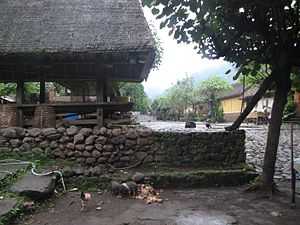Tenganan
| Tenganan Pegringsingan | |
|---|---|
 | |
 Tenganan Pegringsingan | |
 Tenganan Pegringsingan | |
| Coordinates: 8°28′39″S 115°33′59″E / 8.47750°S 115.56639°ECoordinates: 8°28′39″S 115°33′59″E / 8.47750°S 115.56639°E | |
| Country | Indonesia |
| Province | Bali |
| Time zone | WITA (UTC+8) |
Tenganan Pegringsingan is a village in the regency of Karangasem in Bali, Indonesia. Before the 1970's was known by anthropologists to be one of the most secluded societies of the archipelago. Rapid changes have occurred in the village since the 70's, such as the development of local communications by the central government, the opening up to tourism, the breaking of the endogamic rules. [1] Tourists are attracted to Tenganan by its unique Bali Aga culture that still holds to the original traditions, ceremonies and rules of ancient Balinese, and its unique village layout and architecture. It is known for its Gamelan selunding music and geringsing double ikat textiles.
Historical legend of Tenganan Pegringsingan
The people of Tenganan Pegringsingan were selected by the god Indra to administer a territory that was conceived, in accordance with his divine plan to be a microcosm of the world. They were instructed to use every means to keep it pure and clean. the concept of territorial, bodily and spiritual purity and integrity is of paramount importance in this village.[2]
Village layout


The People of Tenganan Pegringsingan
The people of Tenganan Pegringsingan are called Bali Aga—the original Balinese. They descend from the pre-Majapahit kingdom of Pegeng. There are strict rules as to who is allowed to live in the village. Only those born in the village can stay in the village and become full members of the community. There are rules regarding marriage and anyone who marries outside of the village has to leave. A strict protocol regarding marriages among the kin groups have steered the Tengananese through the genetic perils of intermarriage [4] although with increasing contact with the outside world these rules have relaxed somewhat.[5]
Rites and Rituals
Many of the life-cycle rituals of the Tengananes are similar to those of the Balinese in general, but have subtle differences. Some ceremonies are unique. One of the distinguishing features is the use of geringsing. By virtue of their magical qualities geringsing are not only capable of keeping impurities and danger out of the village, but also shield and protect humans from baleful influences during rites of passage as they transition from one phase of life to the next. The Tengananese receive their first geringsing at the hair cutting ritual. His hair is cut and placed in a basket which is placed on a folded geringsing on the balé tengah, on which the Tegananese both enters and leaves the world. In the ceremony that admits a boy or girl to the youth association of the village, they are carried in a geringsing cloth on their father's right shoulder. In the concluding ceremony of teruna nyoma which is the initiation, the candidates wear a geringsing and bear a keris. for the tooth filing ceremony, an essential rite of passage for all Balinese Hindu, the participants pillow is covered by geringsing. After death the grnitals of the deceased are covered by a geringsing hip sash. These cloths may not be used again and so usually ae sold . In the purification of the soul ceremony (muhun) the dead person's presence, which is symbolizes by an inscribed palm leaf, is also arrayed in a geringsing. In the wedding ceremony the groom invites his in-laws to visit his parents home where the couple, dressed in festal geringsing clothing while relatives bring symbolic gifts which are placed on a geringsing cloth.[6]
See also
| Wikimedia Commons has media related to Tenganan Pegringsingan. |
References
- ↑ Breguet, Georges: | From Isolation to Modernity: Demographic Transition and Public Health Changes in Tenganan Pageringsingan (Bali) Over Two Decades: 1976-1995.
- ↑ Hauser-Schäublin, Brigitta.; Nabholz-Kartaschoff, Marie-Louise.; Ramseyer, Urs. (1991). Balinese textile. London: British Museum Press. p. 117. ISBN 0-7141-2505-9.
- ↑ Bali, A Traveller's Companion. Archipalago Press pp.216
- ↑ Bali, A Traveller's Companion. Archipalago Press pp.216
- ↑ Breguet, Georges: | From Isolation to Modernity: Demographic Transition and Public Health Changes in Tenganan Pageringsingan (Bali) Over Two Decades: 1976-1995.
- ↑ Hauser-Schäublin, Brigitta.; Nabholz-Kartaschoff, Marie-Louise.; Ramseyer, Urs. (1991). Balinese textile. London: British Museum Press. p. 127. ISBN 0-7141-2505-9.